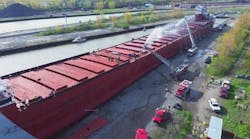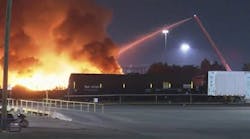It is January once again! Not only a time to adopt well-intentioned resolutions that we are likely to abandon before Valentine's Day, but also a time to step back and reflect on the year behind us as well as plan for the year ahead.
Have you ever noticed how things that sound good in the classroom often do not make it into widespread practice on the fireground? While we may sit in the classroom and fully understand the benefits of properly conducted firefighter rehabilitation, how often do we fully implement it on the fireground? Once on scene, it is easily dismissed. "We didn't have time" or "We simply didn't have the manpower" are common excuses. We fail to see the forest because of all of the trees.
The same thing happens with thermal imagers. While you may know that on the forest level thermal imagers improve firefighter safety and increase the efficiency of operations, at the tree level you may struggle with how to carry it, how to best use it or when to take it with you. You may step off the apparatus without a thermal imager because you simply don't think you will need it.
Several months ago, I happened to be in a fire station when a call went out for a kitchen fire at an apartment complex. After receiving an invitation to ride along (something I rarely turn down), I jumped on the engine and away we went. Upon arrival, crews were confronted with a two-story, multi-family dwelling comprised of four residential units. The front door to Unit 3 was standing open with smoke showing through the door and residents evacuated onto the sidewalk. The engine company, thermal imager in hand, quickly located the fire in the kitchen and suppression was accomplished in less than five minutes.
After most of the smoke had been ventilated, crews re-entered to check for extension and conduct overhaul. This crew was not equipped with a thermal imager (it was still on the truck). Upon exiting the structure, there was some debate as to whether they "got it all." One firefighter described the kitchen as "still smoking"; another described it as "just steam." When questioned by the incident commander (IC), one firefighter thought it "got in the walls" through a breach of the plaster lath, while another firefighter indicated no obvious signs of charring and was dismissive of the fact that the fire had extended.
Having a great relationship with this department and these individual firefighters, I suggested that they could answer both questions by simply taking the thermal imager inside for an evaluation. The response was surprising: both groups of firefighters dismissed the suggestion stating that they "did not need a thermal imager for something simple like overhaul."
About 15 minutes later, while rolling up hose and breaking the hydrant connection, someone reported seeing smoke exiting the end of the building near the roof peak. Crews quickly re-entered the unit, proceeded to the second floor and pulled a section of ceiling. What they found was a heavily involved attic fire. As crews prepared to remount an aggressive attack, I backed up so I could look at the roof with a thermal imager. Several things were immediately clear. First, it was a common attic with no fire walls or stops. This was made evident by the thermal pattern visible on the roof and its consistency of that pattern across the roofline. Second, two specific areas of the roof held greater heat concentrations than the rest. One area was directly above the unit of origin, but the second area was 40 feet away.
As the aerial was making its way to the roof, I took the imager over to the IC. His response: "I don't need a thermal imager." Not wanting to overstep my welcome, I backed off and continued to observe the fire scene both with and without the thermal imager. The on-scene safety officer (SO) saw me watching with a thermal imager and came over to ask what I was looking at. Once I showed him the thermal patterns that were clearly visible, he immediately asked to borrow the imager and he took it straight to the IC, only to receive the same response. Not as easily deterred, the SO insisted that the IC look again and after a brief explanation by the SO, the light bulb went on and for the rest of the scene, the imager was never out of the IC's hands.
The point is this: This is an excellent department. The members are well equipped, well trained and well funded. They have a thermal imager on every piece of apparatus. If asked in a classroom setting, they would describe themselves as big believers in thermal imaging. In class, we often look at the forest; once on-scene, we are confronted with trees — size-up, primary search, fire attack and ventilation. My New Year's wish for you is that you not lose sight of the forest when among the trees.
BRAD HARVEY is the Thermal Imaging Product Manager at Bullard. He is a veteran of public safety as a firefighter, police officer and paramedic and is certified through the Law Enforcement Thermographers' Association (LETA) as a thermal imaging instructor. Harvey has worked as a high-angle rescue instructor and is a certified rescue technician and fire instructor. If you have questions about thermal imaging, you may e-mail him at [email protected].





